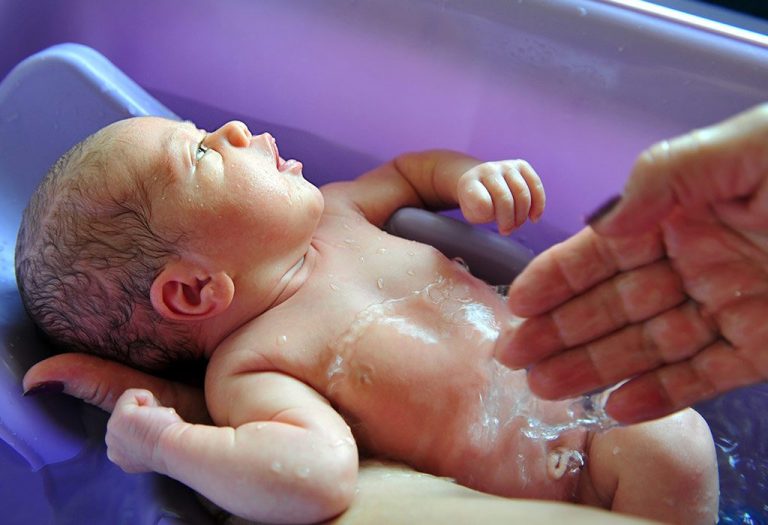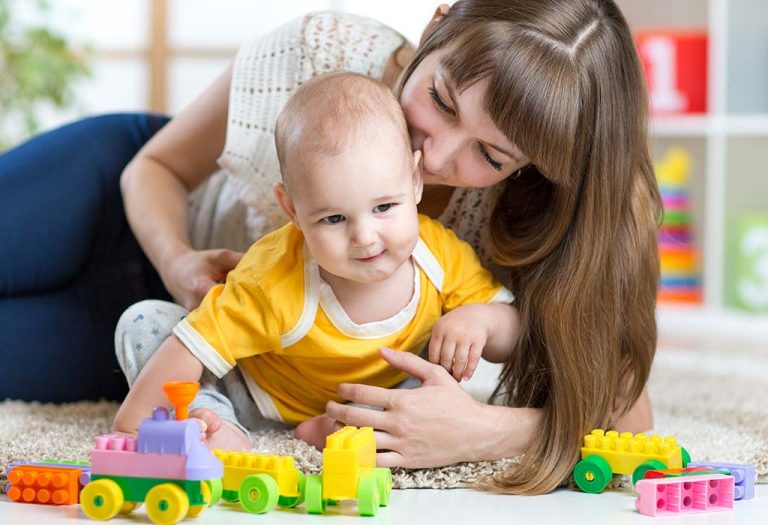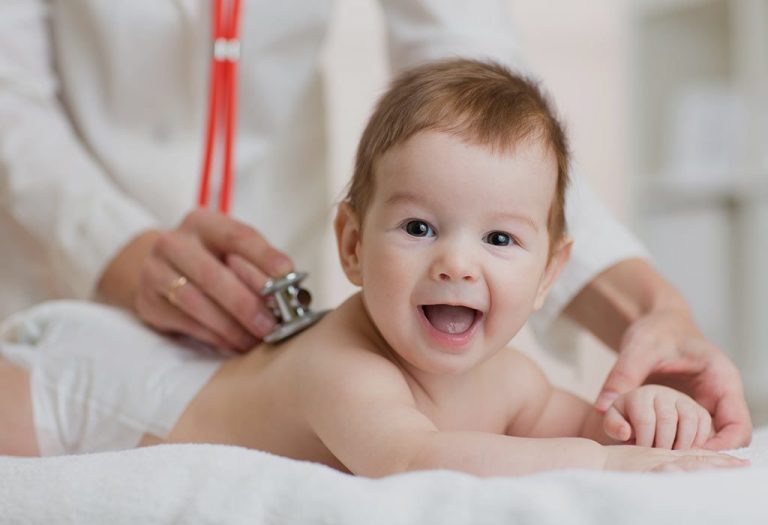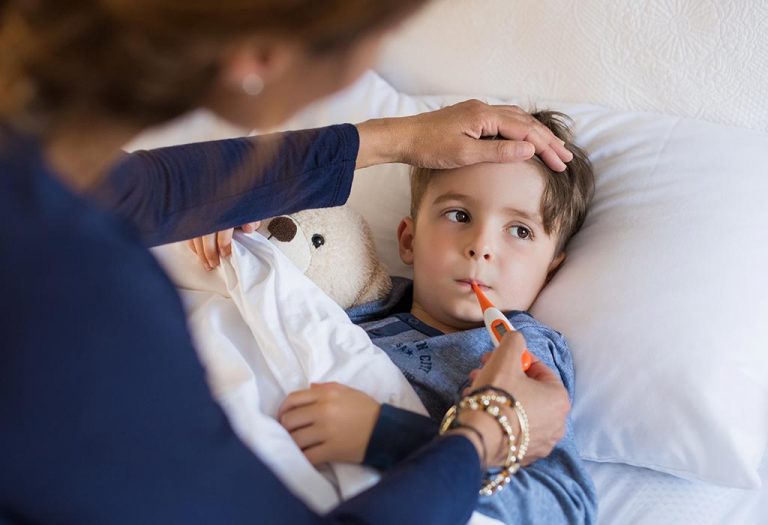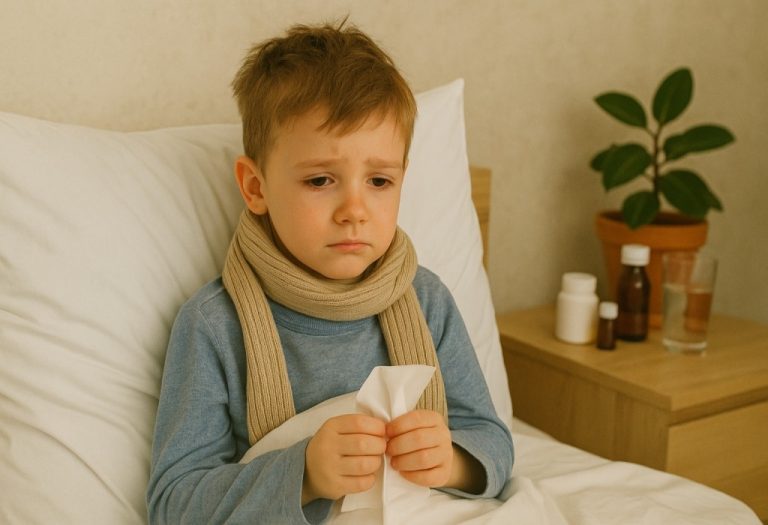How To Bath a Newborn – Procedures and Precautions

Babies have soft and gentle skin, which is sensitive to a lot of outside pollutants and external bacteria in the air, the food, or even the baby products. It is, therefore, vital to understand the key elements that go into grooming a baby, particularly when it comes to hygienic products like soaps, anti-bacterial wipes, and shampoos. Learning how to bathe a newborn is an essential skill for every parent, as it ensures the baby’s skin remains clean and healthy. A newborn bath should be a calming and safe experience, requiring careful preparation and the right tools. Once you have the right products with you, you can set a bathing schedule for your baby, and within no time, bathing the baby can become a fun activity!
Importance of Bathing Your Newborn Baby
Before beginning a bath for a baby, understanding it’s importance is essential. A baby has an extremely weak immune system. This means the baby’s skin is very sensitive and doesn’t have the antibodies to combat most germs that slowly accumulate on your baby. A bath helps by not just removing the unhealthy bacteria on top of the skin but helps exfoliate the skin pores so the baby can sweat out the impurities within. This is also an opportunity for parents to check if the baby has any scars, scabs, rashes or blisters on their skin.
Remember that a baby has very soft skin; adult skin products may harm the baby. We recommend bathing infants only with baby products that are developed especially to keep the skin soft and nourished.
How Often Should You Bathe Your Baby?
Most parents make it a habit to bathe their babies every day from the day she is out of the hospital. This is completely unnecessary. A newborn baby is exposed to very few toxins as she is kept in protective environments. She is yet to consume solid food or have her body exposed to dirty surfaces on a regular basis. Hence, it is recommended that a newborn baby is given a bath only three times a week (1).
Once the baby begins eating solid foods and crawling, you can gradually add more baths in the week over a period of a month. A baby that is crawling and eating solid foods should be given a bath on a daily basis to combat germs that she encounters. Ensure that you build up the bathing sessions on a daily basis, as this allows the baby’s skin to adapt to the frequency of the baths.
Where Should You Bathe Your Baby?
The location of your baby’s bath is very important. Remember that your baby’s immunity is very delicate. If you live in cold areas, bathe your baby in a tub in your bedroom or any other room that is warm (2). If you’re in a hot region, remember to check the water temperature in the room. The location also depends heavily on the type of bath.
If you are bathing the baby in your bedroom, ensure that you heat the room beforehand. Place a slip-resistant mat underneath the tub before you give her a bath. Baths also play a role in maintaining body temperature; try giving your baby a slightly warmer bath if you live in colder regions and try cooling the water if the weather is hot.
Never give a baby a bath in either form of extreme temperatures. Keep in mind that your baby’s tolerance for hot or cold water is not the same as your tolerance. Warm water for you could be hot for the baby, and cool water can be freezing cold for her because of her sensitive skin. Adjust the temperature according to the weather and the baby’s requirements.
When to Bathe a Newborn
The time at which you decide to give your baby a bath is as important as the bath itself. Some general rules to the schedule are:
- If they’re hungry, don’t bathe them (3).
- If they are down with a fever, don’t bathe them.
- If they have skin problems, consult a doctor before you bathe them.
Other than this, here are a few things to consider when scheduling a bath time for a baby:
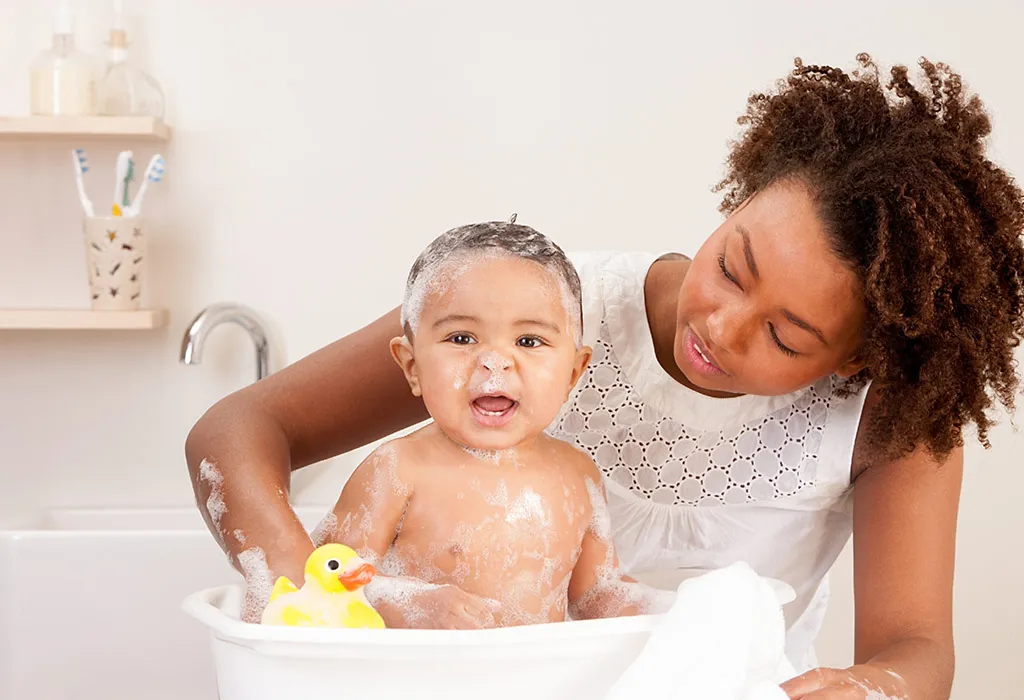
- Evening baths can be a fun and soothing way to prepare your baby for bedtime. They also help you clean away the day’s bacteria.
- Baths at dawn can be a working parent’s best friend. This allows the parent to bond while bathing with the baby before work. Morning baths energise the baby.
- Noon baths are great for cooling the baby’s body temperature down when the day’s heat reaches its peak.
- It is recommended you don’t bathe a baby after dusk as it could leave her susceptible to illnesses.
Keeping this in mind, schedule your baby’s bath based on her and your requirements.
What Kind of Cleanser or Soap Should You Use?
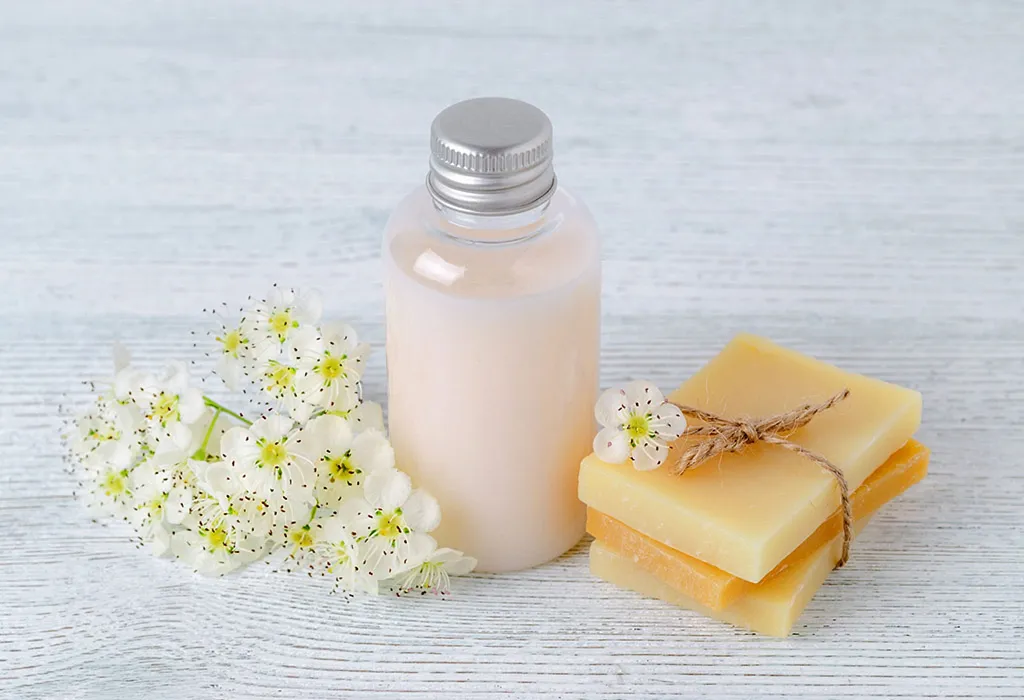
The most important aspect to consider while picking out soap is the pH balance. Slightly acidic or neutral pH balance-based liquid soaps are considered the best as they protect your baby’s delicate skin by not damaging the protective barrier that contains the skin’s moisture. Alkaline soaps that adults use are considered too harsh and may dry out the baby’s skin and cause rashes (4).
It is also recommended that you use liquid bath soaps as they possess baby-friendly moisturisers that help maintain the health of your baby’s skin. It will help to consult a paediatric dermatologist to understand what your baby’s washing needs are.
Different Types of Baby Bath
These are several ways you can bathe your baby:
1. Using a Bath Seat or a Bather
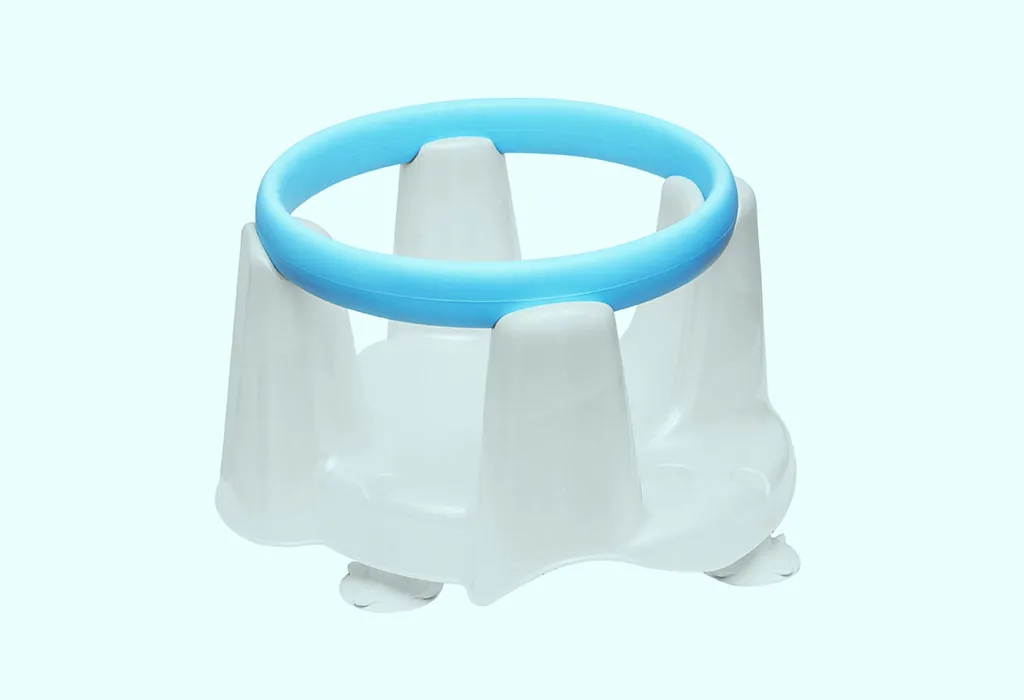
This would be the perfect tool to ensure that you have a good grip on your baby at all times. You can use a netted bather or a bath seat. These keep the baby raised a little so that she is sitting in her own bathwater. This works by letting the water flow over the baby at an angle, then it gently flows into the tub underneath and drains away.
2. The Traditional Bath
This is probably the most comfortable for your baby. It reassures her that she is safe because this bath involves you sitting on the bathroom floor, laying her back against you, stretching her legs and gently letting water sprinkle over her. This has a downside, however, as you will get wet and soapy too.
3. A Tub Bath
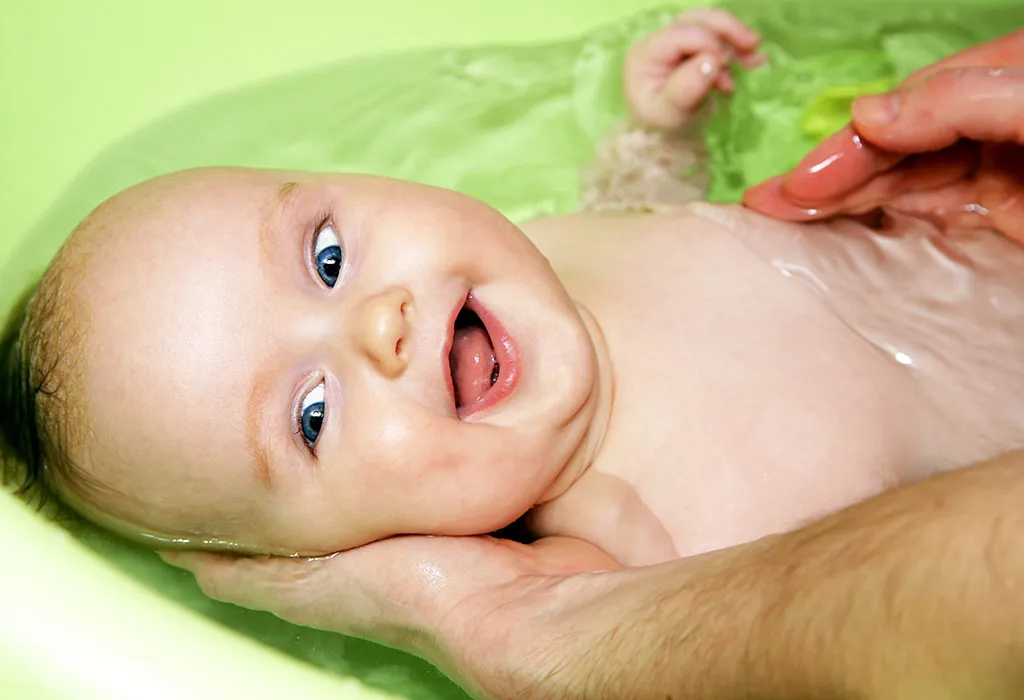
A tub bath is probably the most fun way to bathe your baby. This can also be an amazing bonding experience for the parents and baby.
How to Bathe Your Baby in a Bath Tub
- Place all bath supplies within hand reach to ensure easy access while one hand is always on the baby.
- Fill the tub with warm water. Babies can get major burns if they are put in a temperature of more than 32 degrees for more than 30 seconds.
- Undress the baby completely and slowly put her in the tub feet first while still holding her by the arms.
- Slowly lather the soap onto the baby; use it sparingly at first. Use a cup or hand shower to rinse it off.
- Gently wipe the baby dry and wrap her in a towel. Ensure the towel has a hood-like compartment folded into it; it keeps the ears and the head warm.
Safety Measures to Take in a Bath Tub
It is vital to take these measures for the safety of your child.
- Ensure you always have a hand firmly around the baby.
- Check the temperature twice. Keeping the baby in waters exceeding 32 degrees Celsius can give her major third-degree burns.
- Don’t use too much soap. This can dry her skin out and cause rashes.
- Don’t give her a bath for more than 5 minutes. The excess time in a bath can exhaust the baby.
- Never leave the room or take your attention away from the baby during the bath.
4. A Sponge Bath
In the first few weeks, it may be easier to give your baby a sponge bath. This involves using a warm and moist sponge or cotton wool to wipe your baby. Here are some things that you need to keep in mind during this process.
- Make sure that the room you want to give your baby a sponge bath in is warm.
- Fill a bowl with warm water.
- Place a dry towel under the baby so that you can dry the baby off immediately after the bath.
- Soak a soft sponge or towel in the bowl of warm water and start by gently wiping the baby’s face.
- Ensure not to clean deep inside the ears, too, as you could harm the baby’s eardrum. Instead, clean the ears and behind the ears with care.
- Always use cleansers and wipes formulated for newborns to ensure that your baby’s skin is protected.
- Once you’re through with the washing, carefully pat dry the baby, paying attention to the creases. You can use a mild moisturiser on the skin or wrap the baby up to keep her warm.
What You Need for Your Baby’s Bath?
Here’s what you need to draw your baby’s bath (5).
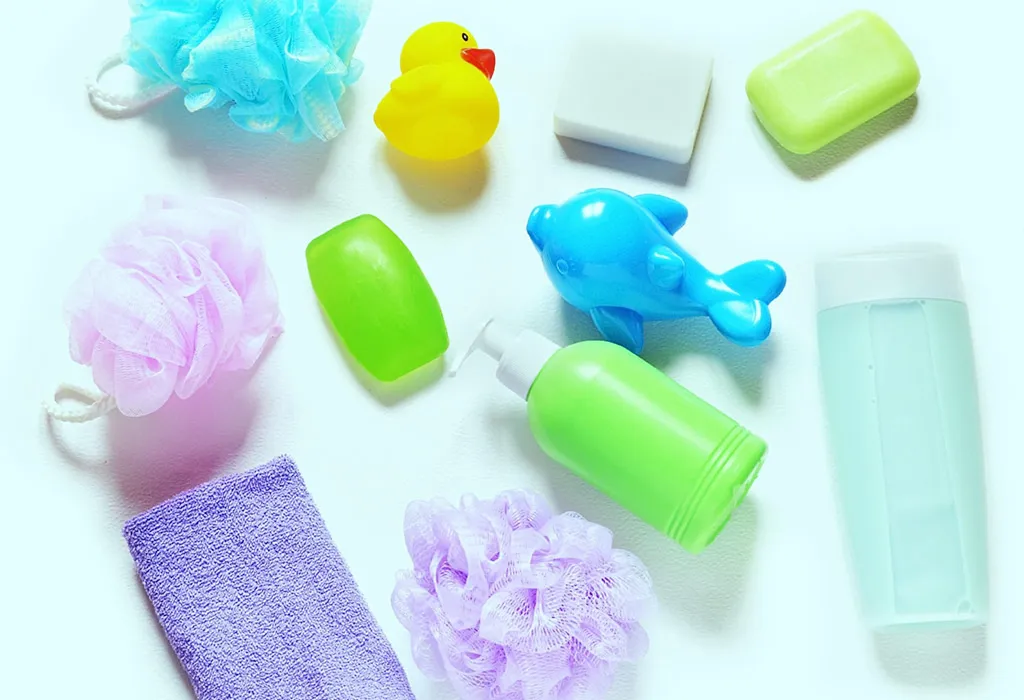
- You’ll need an appropriately sized tub. Use plastic as it won’t have any sharp edges.
- A mild cleanser made especially for babies.
- Soft sponge to distribute the water.
- Plain cotton cleaning pads to clean your baby’s eyes.
- Soft towel to dry your baby gently.
When and How to Wash a Baby’s Face
Wash your baby’s face right before her bath. Dampen a sponge or cotton wool in warm water and gently wipe the face. Ensure that the water is not too hot for the baby’s skin. Gently wipe over her eyes. Also, wipe behind the baby’s ears and the exterior part of the ears. Do not use your fingers or a cotton swab to clear earwax, as this may cause blockage or damage the eardrum. Before washing away any dried mucus near the eyes or nostrils, dab it with a ball of wet cotton wool to make it softer.
You do not need any soap or cleanser to clean the baby’s face.
How to Bathe a Newborn?
Wondering how to go about with your newborn’s bath? Here is how to bath a baby correctly (6):
- Fill the tub with a few inches of lukewarm water. If you have a thermometer, you can check to make sure that the water is between 90 and 100 degrees Fahrenheit. Check the temperature against the inner side of your wrist.
- Support your baby’s head and neck and gently place her in the tub. Continue to support her with one arm.
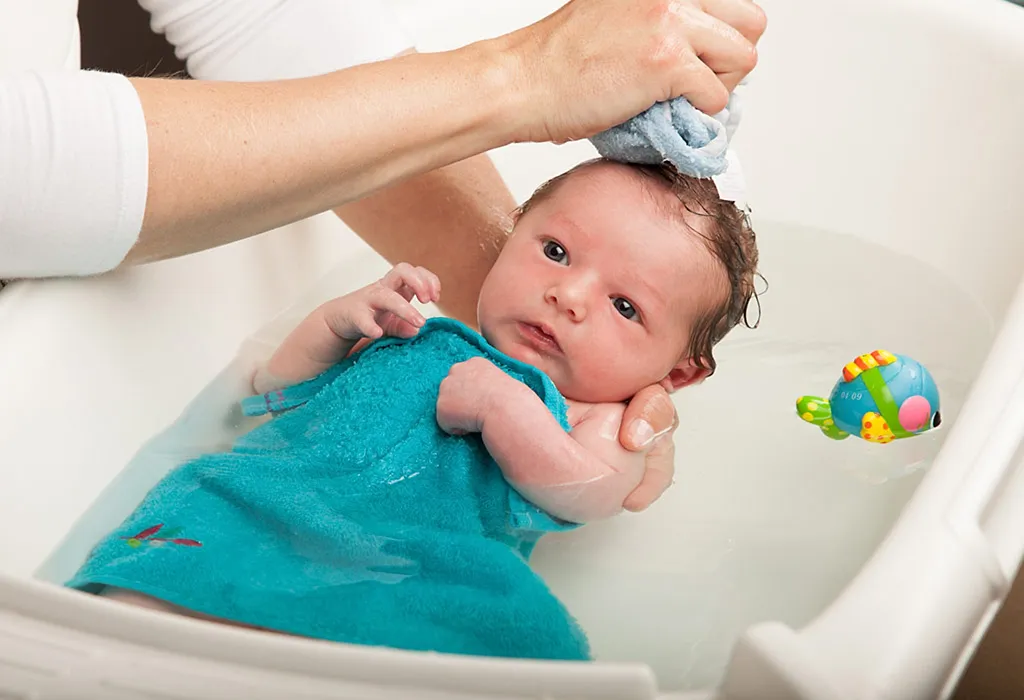
- Use the cotton pads to clean your baby’s eyes. Soften them in water and gently wipe outward. Use one pad for only one eye. Use the soft sponge to clean her mouth, nose, face, neck, and ears.
- Use a gentle cleanser made for babies and gently clean the rest of the body with the sponge.
- Wash the diaper area last from front to back. Do not pull the foreskin back in case your boy is uncircumcised.
- All babies enjoy being in the water. Make sure that you keep pouring water over her body to ensure that she stays warm.
- Remove your baby gently from the tub while supporting her head and neck, and quickly wrap her in a towel.
- Use a soft towel to clean your baby’s skin thoroughly. Don’t forget to clean in all the creases and always pat dry.
- Use a baby moisturiser to lock in moisture. Your baby’s skin is delicate and prone to drying out.
Precautions to Take for Safe Baby Bathing
Here are some precautions to be followed during your baby’s bath time (7):
- Do not leave your baby unattended in the water even for a second. If you must answer something urgently, remove your baby from the water and take her with you.
- Do not keep the water running while your baby is in the tub. Temperature changes can be sudden and unexpected.
- Reduce the temperature settings on your water heater to less than 120 degrees Fahrenheit.
Some Important Baby Bathing Tips
Here are some important tips to follow when bathing a newborn:
- Your baby will most likely fall asleep after a warm bath. Make sure that you keep this in mind when you schedule her bath time.
- Clean only what you can see; do not try to clean the ear canal or inside the nose.
- Place a non-skid mat in the area where you will be bathing your baby. This will prevent any accidents.
- Never leave your baby unattended in the water.
FAQs
1. What should I do if my baby cries during bath time?
If your baby cries during a bath, it could be due to discomfort, fear, or temperature issues. Ensure the water is warm (not hot), the room is comfortably warm, and you’re using gentle, reassuring touches. Gradually introducing your baby to water with a calm and soothing approach can help them feel more comfortable over time.
2. Can I add essential oils or herbs to my baby’s bathwater?
While some parents consider adding essential oils or herbs for aromatherapy or skin benefits, it’s generally not recommended for newborns. Essential oils can be too potent and may cause skin irritation or allergic reactions. Always consult a pediatrician before introducing any additives to your baby’s bath.
3. Should I bathe my baby in hard water or use filtered water?
Hard water contains high levels of minerals like calcium and magnesium, which can dry out your baby’s skin and leave a residue. If you live in an area with hard water, consider using a water softener or filtered water for your baby’s bath to prevent skin irritation.
4. Is it safe to bathe my baby in a sink or a bathtub designed for adults?
While adult bathtubs can be used with caution, they may not provide the necessary support for a newborn. Sinks can be convenient but ensure they are thoroughly cleaned and padded to prevent slips. Opt for a baby bathtub or a specially designed bathing seat for added safety and comfort.
This was all about giving a newborn bath. It is vital to understand the needs of your baby before giving her a bath. We recommend specially designed baby hygiene products when bathing a baby. It is crucial to keep an eye out for lesions, blister or rashes when grooming your child, if you notice any, consult a specialist as soon as you can. Try organic baby soaps and shampoos while bathing and organic moisturisers and wipes for general use.
References/Resources:
1. Mayo Clinic – Baby bath basics: A parent’s guide
2. American Academy of Pediatrics – Bathing Your Baby
3. NHS – Washing and bathing your baby
4. Stanford Medicine – Bathing and Skin Care for the Newborn
5. Cleveland Clinic – Bath Time for Baby: When and How To Bathe Your Newborn
6. Nemours Kids Health – Bathing Your Baby
7. Child Accident Prevention Trust – Safe baby bath time: Top tips for parents and carers
Also Read:
Co-Bathing with Infant
Sponge Bath vs Tub Bath for Infants
Ideal Water Temperature for Infant Bath
How Often Should You Bathe a Baby?
Was This Article Helpful?
Parenting is a huge responsibility, for you as a caregiver, but also for us as a parenting content platform. We understand that and take our responsibility of creating credible content seriously. FirstCry Parenting articles are written and published only after extensive research using factually sound references to deliver quality content that is accurate, validated by experts, and completely reliable. To understand how we go about creating content that is credible, read our editorial policy here.






